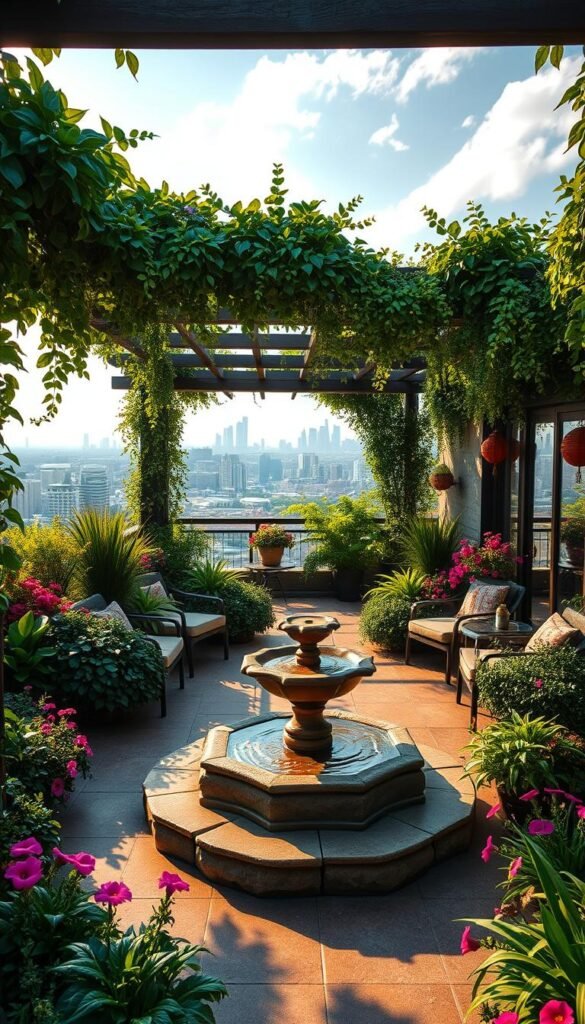Imagine stepping outside your door to a vibrant sanctuary above the bustling streets. A well-planned elevated green space offers more than beauty—it’s a functional extension of your home that blends relaxation with sustainability. You’ll enjoy fresh herbs, colorful blooms, and even homegrown veggies while reducing your carbon footprint.
Transforming unused areas into lively retreats requires smart planning. Start by assessing weight limits and sunlight exposure—key factors for selecting plants and materials. Many urban dwellers find inspiration in container setups for urban balconies, adapting similar strategies for larger surfaces.
Your elevated haven can serve multiple purposes. Create cozy corners for morning coffee, install vertical planters to maximize growing areas, and choose weather-resistant furniture for gatherings. With proper drainage and irrigation systems, your plants will thrive through seasonal changes.
This guide simplifies the process, from securing permits to choosing low-maintenance species. You’ll discover how to craft a personalized escape that boosts your quality of life while adding value to your property. Let’s turn that blank concrete canvas into your private slice of nature.
Exploring the History and Benefits of Rooftop Gardens
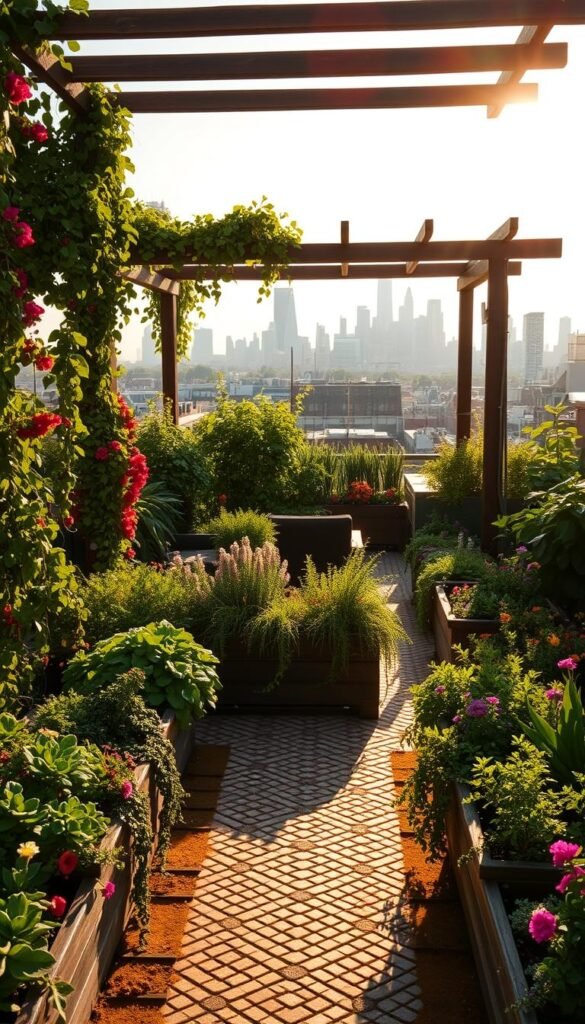
Did you know cultivating plants above ground isn’t a modern trend? Ancient Mesopotamians built stone terraces with trees and flowers over 4,000 years ago to escape harsh climates. These early innovators paved the way for iconic projects like the legendary Hanging Gardens of Babylon—though historians still debate its exact location.
From Stone Terraces to City Skylines
Archaeologists discovered a preserved U-shaped terrace buried by Mt. Vesuvius, proving Romans enjoyed elevated plant life. Fast-forward to 1882 New York: the Casino Theatre’s flourishing sky-high retreat sparked a movement. Madison Square Garden earned its name from its original lush layout, hosting social events 12 stories above bustling streets.
Triple-Layer Advantages for Urban Life
Growing herbs or flowers 30 floors up does more than beautify. Studies show 30 minutes of gardening lowers stress hormones by 20%. Your plants filter pollutants, while their roots absorb rainwater—reducing flood risks citywide.
Communities thrive when neighbors gather among potted tomatoes and marigolds. One Brooklyn resident reported:
“Our building’s shared space cut summer AC bills by 40%, and kids now beg to water basil instead of binge-watching cartoons.”
Beyond personal joy, these leafy layers combat urban heat islands. Chicago’s City Hall green roof stays 50°F cooler than nearby asphalt roofs in July. Your planter boxes become mini wildlife habitats, attracting pollinators that keep urban ecosystems buzzing.
Essential Planning and Preparations for Your Rooftop Oasis
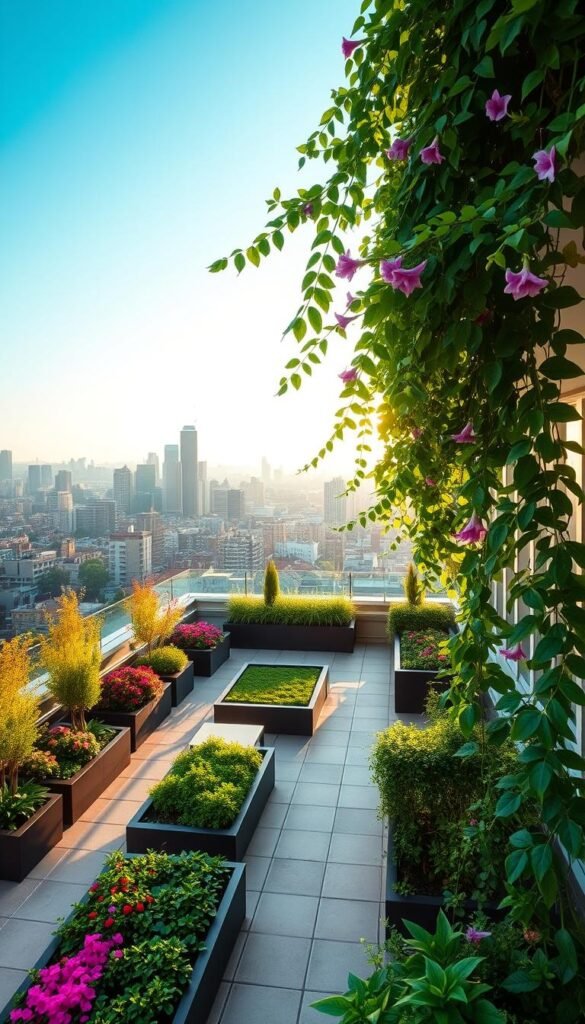
Transforming your elevated space into a thriving retreat begins with smart groundwork. Three critical factors determine success: legal approvals, weight management, and material choices that protect your building.
Legal Compliance and Load Limits
Start by checking local regulations—many cities require permits for structural modifications. Your landlord or HOA will need to approve plans before you touch a single planter. Consult a structural engineer to calculate load capacities. A typical roof holds 20-50 lbs per square foot when dry—heavy rains add unexpected weight.
Smart Material Selection
Traditional dirt weighs 75-100 lbs per cubic foot—lightweight potting mixes cut this by 60%. Look for blends with perlite or coconut coir. Pair these with containers made from recycled plastic or breathable fabric.
| Material | Weight (Empty) | Durability | Best For |
|---|---|---|---|
| Fiberglass | 3-5 lbs | 10+ years | Large shrubs |
| Plastic | 1-2 lbs | 5-7 years | Herbs & flowers |
| Fabric | 0.5 lbs | 3-5 years | Vegetables |
Don’t skip the waterproof membrane—it prevents leaks that could damage ceilings below. Beginners often find container gardening basics helpful when starting their elevated projects. Keep tools simple: a collapsible watering can and foldable stool save precious square footage.
Rooftop Garden Design: How to Create a Green Oasis in the City
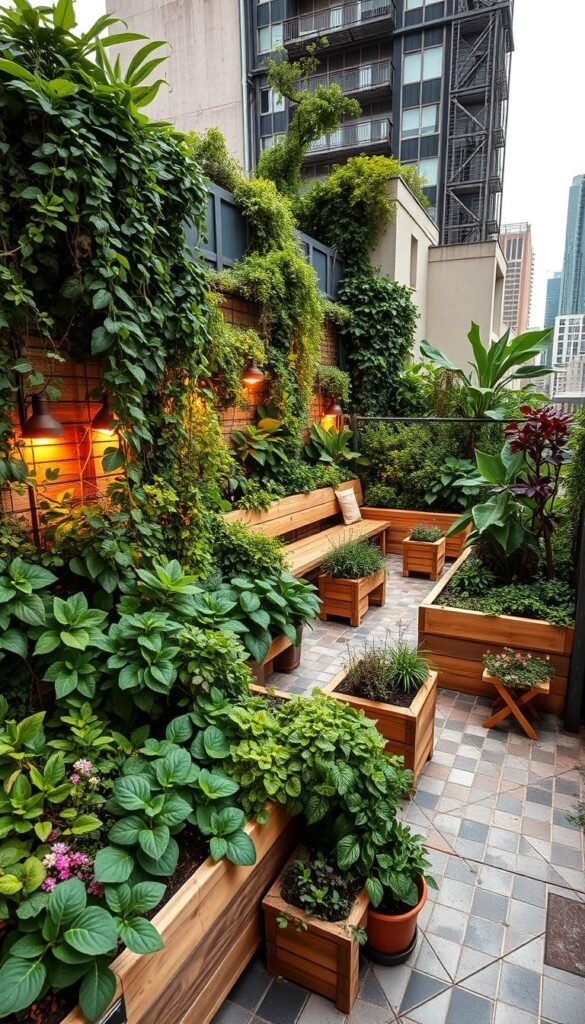
Crafting your elevated retreat starts with a clear blueprint. Before choosing plants or furniture, map out your space like an architect. Grab a tape measure and sketchpad—precision here prevents headaches later.
Defining Your Space and Overall Vision
Divide your area into activity zones. A cozy corner for morning yoga? A dining patio for sunset dinners? Mark these on paper first. Urban dwellers often blend functions—herb boxes double as privacy screens, while benches hide storage compartments.
Think about sightlines. Position taller plants to frame skyline views without blocking breezes. Use low walls or trellises to carve intimate rooms within open layouts. One Brooklyn resident transformed their 400 sq ft roof into three distinct zones:
| Zone | Key Features | Multi-Purpose Elements |
|---|---|---|
| Dining | Foldable table, hanging lights | Herb wall doubles as decor |
| Lounge | Weatherproof loveseat, fire pit | Storage ottomans |
| Growing | Vertical planters, drip irrigation | Movable raised beds |
Color schemes matter. Cool blues and purples recede visually, making tight spaces feel larger. Warm reds and yellows create cozy nooks. For year-round interest, mix evergreens with seasonal blooms. Remember pathways—keep them 24-36 inches wide for comfortable movement.
Don’t overlook practical needs. Hide compost bins behind decorative screens. Coordinate with neighbors through shared green projects to source materials sustainably. Your artful layout should evolve as your needs change—leave room for future experiments.
Choosing the Perfect Plants and Containers for Urban Living
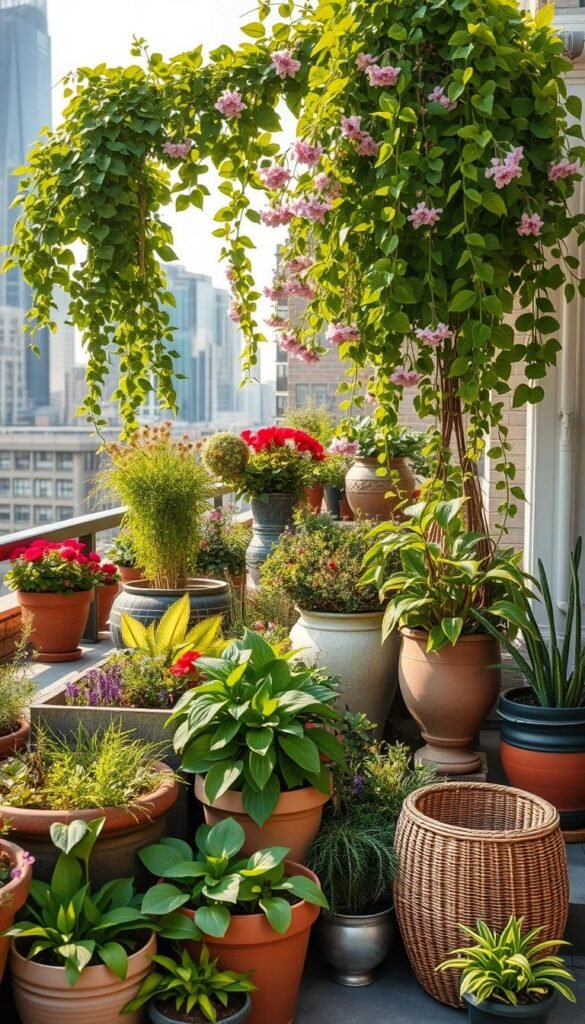
Your plant choices make or break your elevated green space. Combine hardy varieties with smart containers to build a thriving ecosystem that survives summer heat and winter winds. Let’s explore resilient options that deliver color, texture, and fresh flavors.
Drought-Tolerant and Sun-Loving Varieties
Prioritize species that laugh at dry spells. Cacti and succulents store water in their leaves, while evergreens like “Blue Star” juniper add year-round structure. For seasonal drama, try red-and-white hydrangeas—their blooms shift colors based on soil acidity.
| Plant | Key Features | Best Use |
|---|---|---|
| Kousa Dogwood | Spring blooms, 15-20 ft height | Natural shade provider |
| Cherry Tomatoes | Continuous harvest | Container veggies |
| Decorative Grasses | Wind-resistant | Privacy screens |
Sun worshippers like gladiolus and chili peppers thrive in 6+ hours of daily light. A Chicago gardener shared:
“My cherry tomatoes produced 50 lbs last summer using just self-watering pots!”
Container Options and Irrigation Solutions
Lightweight materials prevent structural stress. Recycled plastic planters work for herbs, while fabric grow bags suit root veggies. Pair these with drip irrigation lines on timers—they use 30% less water than hand-watering.
Mix hanging petunias with cascading strawberries for vertical interest. Sage and rosemary grow so vigorously, you’ll share cuttings with neighbors. Remember: group plants by water needs to simplify care.
Incorporating Vertical Gardens and Decorative Hardscape Elements
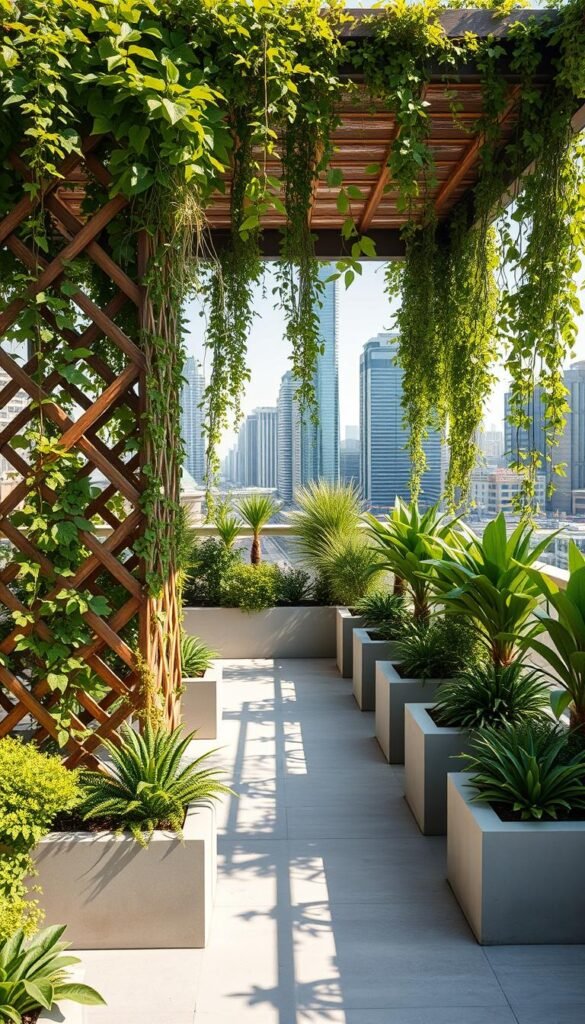
Elevate your urban retreat by blending vertical greenery with smart structural elements. This approach transforms blank walls into lush displays while carving out intimate zones for relaxation. You’ll gain natural privacy and dynamic visual interest without sacrificing precious square footage.
Vertical Garden Inspirations for Limited Space
Repurposed wooden pallets become instant planters when filled with succulents or herbs. Attach them to railings as living dividers between dining and lounge areas. One Chicago gardener shared:
“My upcycled pallet wall grows strawberries and thyme—it hides AC units while smelling amazing!”
Metal screens with climbing jasmine or clematis create living curtains that block neighboring views. For quick shade, position tall grasses like feather reed in slender containers along your terrace edges. Their gentle rustling adds soothing white noise against city clamor.
Enhancing Privacy with Plant Walls and Hardscape Features
Combine functional and decorative elements using these strategies:
- Install wall-mounted planters with trailing ivy above seating areas
- Use trellises as backdrops for container-grown dwarf citrus trees
- Position corrugated metal panels as windbreaks behind ornamental grasses
For permanent solutions, build planter boxes directly into railings with drip irrigation. Flexible vertical gardening systems let you rotate seasonal blooms while maintaining year-round coverage. Pair these with stone veneer accents or patterned concrete tiles for textural contrast.
Your landscape becomes multi-dimensional when layering heights and materials. Tall ferns in corner planters soften angular architecture, while low-growing sedum carpets green up walkways. Remember: every vertical surface offers potential for growth and creative expression.
Creative Styling, Seasonal Planting, and Maintenance Tips
Turn your elevated space into a living canvas that shifts with nature’s rhythm. Blend evergreens like boxwood with seasonal stars—spring pansies, summer geraniums, and autumn mums. This approach maintains structure while letting you refresh color schemes effortlessly.
Artful Arrangements Inspired by Nature
Mix matte-leafed hostas with glossy camellias for visual intrigue. Try the thriller-filler-spiller method: tall grasses as focal points, trailing ivy softening edges. Add pops of vibrancy with container-grown blooms that adapt to changing light conditions.
Seasonal Care Made Simple
Solar stake lights cast warm glows on stone pathways after sunset. Waterproof wicker chairs withstand summer storms when paired with sunshade pergolas. For thirsty plants, install drip lines on timers—they’ll hydrate roots at dawn without daily effort.
Rotate pots weekly for even growth. Check leaves monthly for pests, using organic sprays if needed. With smart planning, your sanctuary stays lush through frosts and heat waves, becoming a cherished family retreat across all seasons.

